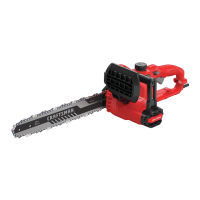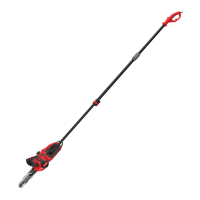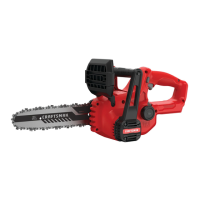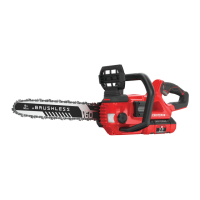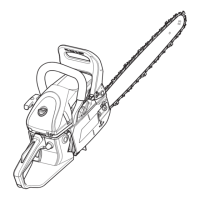Kickback may occur when the nose or tip
of the guide bar touches an object, or when
the wood closes in and pinches the saw
chain in the cut.
Tip contact in some cases may cause a
sudden reverse reaction, kicking the guide
bar up and back towards the operator.
Pinching the saw chain along the top of the
guide bar may push the guide bar rapidly
back towards the operator.
Either of these reactions may cause you
to lose control of the saw which could
result in serious personal injury. Do not rely
exclusively upon the safety devices built into
your saw. As a chainsaw user, you should
take several steps to keep your cutting jobs
free from accident or injury.
Kickback is the result of tool misuse and/or
incorrect operating procedures or conditions
and can be avoided by taking proper
precautions as given below:
• Maintain a firm grip, with thumbs
and fingers encircling the chainsaw
handles, with both hands on the saw
and position your body and arm to
allow you to resist kickback forces.
Kickback forces can be controlled by the
operator, if proper precautions are taken.
Do not let go of the chainsaw.
• Do not overreach and do not cut
above shoulder height. This helps
prevent unintended tip contact and
enables better control of the chainsaw in
unexpected situations.
• Only use replacement bars and
chains specified by the manufacturer.
Incorrect replacement bars and chains
may cause chain breakage and/or
kickback.
• Follow the manufacturer’s sharpening
and maintenance instructions for the
saw chain. Decreasing the depth gauge
height can lead to increased kickback.
THE FOLLOWING
PRECAUTIONS SHOULD BE
FOLLOWED TO MINIMIZE
KICKBACK:
(1.) Grip Saw Firmly. Hold the chainsaw
firmly with both hands when the motor is
running. Use a firm grip with thumbs and
fingers encircling the chainsaw handles.
Chainsaw will pull forward when cutting
on the bottom edge of the bar, and push
backward when cutting along the top edge
of the bar.
(2.) Do not over reach.
(3.) Keep proper footing and balance at all
times.
(4.) Don’t let the nose of the guide bar
contact a log, branch, ground or other
obstruction.
(5.) Don’t cut above shoulder height.
(6.) Use devices such as low kickback
chain and reduced kickback guide bars that
reduce the risks associated with kickback.
(7.) Only use replacement bars and chains
specified by the manufacturer or the
equivalent.
(8.) Never let the moving chain contact any
object at the tip of the guide bar.
(9.) Keep the working area free from
obstructions such as other trees, branches,
rocks, fences, stumps, etc. Eliminate or
avoid any obstruction that your saw chain
could hit while you are cutting through a
particular log or branch.
(10.) Keep your saw chain sharp and
properly tensioned. A loose or dull chain
can increase the chance of kickback. Check
tension at regular intervals with the motor
stopped and tool unpllugged, never with the
motor running.
(11.) Begin and continue cutting only with
the chain moving at full speed. If the chain is
moving at a slower speed, there is a greater
chance for kickback to occur.
(12.) Cut one log at a time.
(13.) Use extreme caution when re-entering
a previous cut. Engage ribbed bumpers into
wood and allow chain to reach full speed
before proceeding with cut.
(14.) Do not attempt plunge cuts or bore
cuts.
(15.) Watch for shifting logs or other forces
that could close a cut and pinch or fall into
chain.
KICKBACK SAFETY
FEATURES
WARNING: The following features are
included on your saw to help reduce the
hazard of kickback; however such features
will not totally eliminate this dangerous
reaction. As a chainsaw user do not rely only
on safety devices. You must follow all safety
precautions, instructions, and maintenance in
this manual to help avoid kickback and other
forces which can result in serious injury.
• Reduced-Kickback Guide Bar,
designed with a small radius tip which
reduces the size of the kickback danger
zone on bar tip. A reduced - kickback
guide bar is one which has been
demonstrated to significantly reduce the
number and seriousness of kickbacks
when tested in accordance with safety
requirements for electric chainsaws.
• Low-Kickback Chain, designed with a
contoured depth gauge and guard link
which deflect kickback force and allow
wood to gradually ride into the cutter. A
low-kickback chain is a chain which has
met kickback performance requirements of
ANSI B175.1-1991.
• Do not operate chainsaw while in a
tree, on a ladder, on a scaffold, or
from any unstable surface.
• Hold tool by insulated gripping
surfaces when performing an
4
